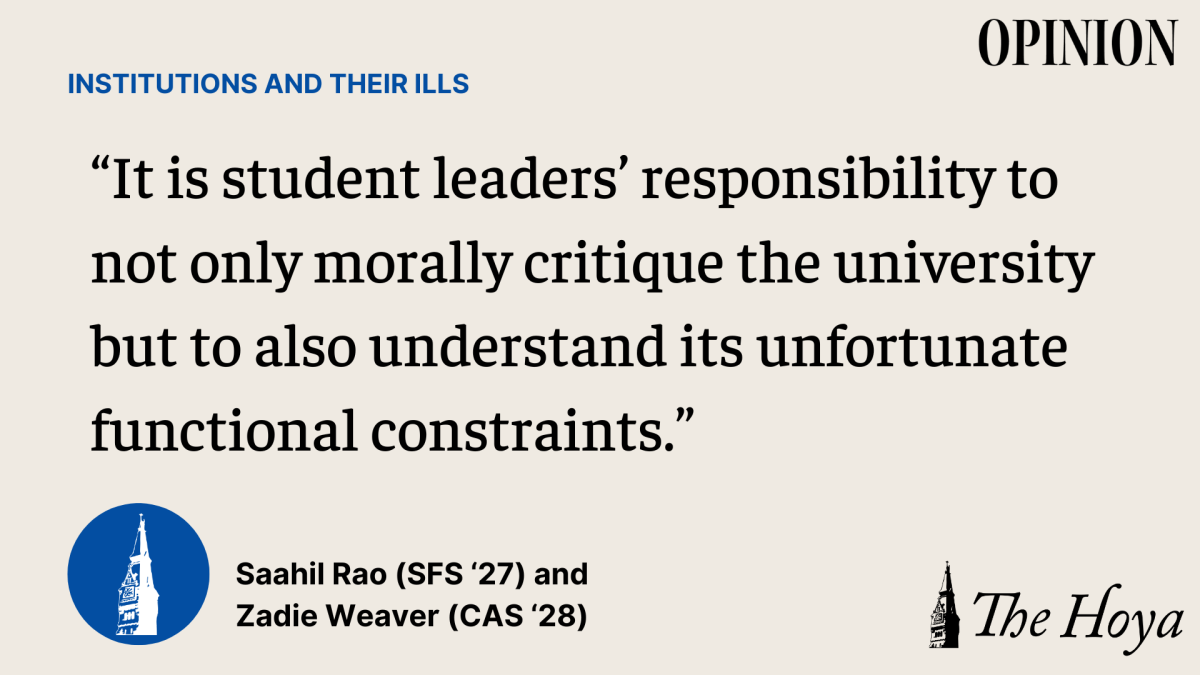
Georgetown University’s primary responsibility in admissions should be to make entry into the university as meritocratic as possible, for as many people as possible, while sustaining itself as an institution. We should strive to enroll the best students in the world, regardless of ability to pay. Indeed, great students are the largest part of what makes an educational institution great.
Yet, according to legal filings, recently retired university President John J. DeGioia (CAS ’79, GRD ’95) allegedly compiled an annual “president’s list” of around 80 students with close relations to the wealthiest families and corporations in the United States, forwarding it to the admissions office, where almost all received guaranteed admission.
This practice has received fair criticism, but may require a closer examination. Georgetown, despite being an elite private institution, has been historically underfunded (especially in its student life) when compared to its peers. Understanding this context — and the negative consequences that come from it — leads to a different evaluation of DeGioia’s actions.
Notably, some of this criticism has come from the Georgetown University Student Association’s (GUSA) leaders, President Ethan Henshaw (CAS ’26) and Vice President Darius Wagner (CAS ’27). Writing in The Hoya, Henshaw and Wagner, along with Felix Rice (CAS ’26) and Asher Maxwell (CAS ’26), passionately aspersed the “president’s list” and the university’s broader admissions.
“Georgetown robbing seats from the most qualified applicants to give to the children of the rich and powerful is upsetting enough, but it is only one part of the system that Georgetown has created that excludes working- and middle-class students at every step of the process,” the group wrote. “Georgetown charges exorbitant tuition while offering insufficient financial aid packages, which fail to yield working-class applicants.”
Morally, we agree with Wagner and Henshaw. It is crass to admit students for their ties to money. But in practice, Georgetown has long needed a substantial increase in funding, which DeGioia has delivered.
Over his 20-year tenure, DeGioia grew Georgetown’s endowment by $3 billion, enabling the university to admit more low-income students and offer more robust financial aid packages. Yet, even so, Georgetown’s endowment is significantly smaller than its academic peers. In 2001, before DeGioia became president, Georgetown’s endowment was valued at just $70 million. For reference, in the same year, the University of Chicago’s endowment stood at $3.5 billion and Columbia University’s at $4.3 billion. Despite DeGioia’s successful efforts to grow the endowment, it is still the smallest among private universities in the national top 25, save for Carnegie Mellon University.
A small endowment restricts a university’s ability to provide a high-quality and worthwhile education, not to mention the financial aid it can give its students. Indeed, in 2016, Georgetown identified that its financial aid packages for lower-income students are less competitive than those of peer institutions, leading to lower enrollment from such students.
As Henshaw and Wagner highlighted, this quagmire leaves Georgetown less financially diverse than peer schools, lagging behind them in the percentage of its student body that receives Pell Grants. Since an overwhelming majority of Pell Grant recipients also receive substantial additional financial aid, this percentage serves as a key measure of how financially accessible the university is to those it admits under its need-blind policy.
In this context, then, DeGioia’s approach becomes more understandable: As Dean of Admissions Charles Deacon (CAS ’64, GRD ’69) explained in a memo to admission staff, admitting students with ties to wealth provides a solution to Georgetown’s comparative financial shortcomings.
“The university is under-funded and under-endowed, and we need to do a better job of enlisting the support of America’s wealthiest families and corporations in assisting us,” Deacon wrote. “Special interest admits should provide this type of opportunity to enhance and strengthen our future.”
A viral Fizz post, written anonymously by a student allegedly on “near-full financial aid,” puts it more simply. “I don’t mind them admitting rich legacies,” the post reads. “Someone’s gotta pay for tuition, and it’s not me.”
If admitting these 80 “president’s list” applicants helps Georgetown secure donations from the wealthy and channel that money to lower-income students, perhaps it is understandable after all. While we are not arguing that admitting students based on wealth is fair, we simply recognize why it might happen.
We urge student leaders to keep Georgetown’s financial situation and DeGioia’s enormous effort to grow Georgetown’s endowment in mind in discussions and policy proposals in reaction to the “president’s list.” It is student leaders’ responsibility to not only morally critique the university but to also understand its unfortunate functional constraints.
We argue that the university’s admissions should aim to enroll the best students in the world, regardless of ability to pay. It seems DeGioia was trying to enable Georgetown to do just that.
Saahil Rao is a sophomore in the School of Foreign Service, and Zadie Weaver is a first-year in the College of Arts & Sciences.